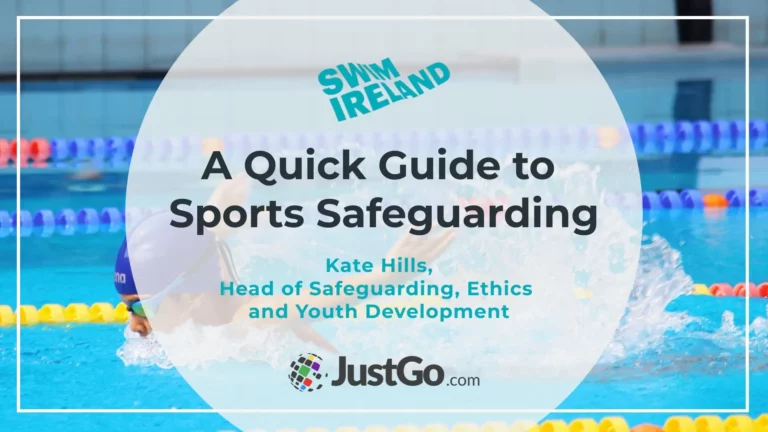JustGo Insights

Safeguarding is and has always been a hot topic within sports communities. Sports should be a safe space for everyone, but unfortunately, we’re all too familiar with the myriad of safeguarding abuse and misconduct occurring across the sporting community.
However, when it comes to sports safeguarding, numerous questions arise. What exactly does safeguarding entail? What role should organisations play in ensuring safe sport? What protocols should be in place to uphold safe sporting practices?
As part of our global safeguarding campaign, we spoke with Kate Hills, the Head of Safeguarding, Ethics, and Youth Development at Swim Ireland, to understand the fundamentals of sports safeguarding. We explored key considerations for building a safer community and discussed how organisations can embark on their safeguarding journey.
Notably, Kate Hills will be presenting in our upcoming Irish Roundtable Discussion in a few weeks. Her presentation promises to be a rich source of insights, and we’re sure you’ll find her perspectives on sports safeguarding incredibly insightful!
According to Kate, sports safeguarding encompasses all aspects of child protection and child welfare matters. This includes establishing robust policies, standards, and implementations for safeguarding. These measures can help you to address and investigate potential risks that may threaten the safety of young people.
Let’s look at an example to illustrate the importance of safeguarding protocols. While safeguarding covers a broad spectrum of issues, let’s consider the risk associated with photographing children. While this may seem like a minor issue, a photograph is often the easiest way to identify a child and which team they belong to. Therefore, it’s imperative to consider who will be taking pictures at events, how these images will be stored, and where they will be shared.
Once these points have been identified, you need to establish clear boundaries around the safe use of imagery. This could involve determining who is permitted to photograph events in advance, restricting access to certain areas for photography (such as prohibiting photography in changing rooms), and maintaining records of who captured each image. By implementing such measures, organisations can significantly mitigate the risks associated with photographing children and contribute to a safer sporting environment for all participants.
The straightforward answer lies in the fact that young people deserve the opportunity to engage in sports within a secure environment. However, Kate shared one eloquent phrase encompassing the importance of safeguarding policies:
“Being well-meaning is not good enough for young people.”
While you might have the best intentions in keeping your sport safe, the reality is that safeguarding breaches or inappropriate behaviour can still occur. Plus, repeated violations of the code of conduct or organisational boundaries can lead to the normalisation of unsafe practices within your community. Without individuals speaking up or addressing issues, the lines between acceptable and unacceptable behaviour can quickly blur, paving the way for a rise in inappropriate conduct.
Your safeguarding policies can clarify which behaviours are deemed acceptable and which aren’t. This sends the powerful message that your club, organisation, and sport are committed to providing a safe space for everyone.
Kate shared a valuable approach to identifying safeguarding risks by considering a young person’s experience within your organisation. Think of it this way: When a young athlete is dropped off at your facility, what happens next? Who do they meet? Are their peers of similar age and gender, or are they part of a mixed-gender group?
If your sport is open to the public, the athlete might interact with individuals who are not officials or coaches but rather members of the public. Therefore, determining who is permitted on your premises is crucial.
It’s also worth thinking about the facilities within your club or arena. Are they adequately equipped and maintained to ensure the well-being of young athletes?
Going through a young person’s journey step by step is a good way to gain clarity into possible safeguarding risks. By examining each step of the process, your team can develop and implement policies and strategies to minimise these risks effectively.
When it comes to prevention, it’s important to implement measures aimed at reducing the likelihood of harm to individuals, particularly children and vulnerable adults.
Let’s start with your recruiting process. Have all of your staff been vetted properly? Are they safe to work with children? Ensuring that your recruiting process includes thorough vetting is a great first step. Additionally, examining your sporting culture is crucial because culture significantly influences safeguarding practices. For example, what are the expectations placed on your athletes? Is there a risk of bullying, or is there a supportive environment for them to thrive and develop?
It’s also worth appointing an advocate, such as a child welfare officer or safeguarding officer, to ensure that the children’s welfare is protected. If you don’t have the option, you might consider collaborating with someone experienced in your sport to devise strategies for addressing these issues.
Remember, your end goal is to ensure a safe and nurturing environment for all participants. You want to establish a sporting culture that values respect, equality, and the well-being of all participants.
If you would like to know more, check out Kate’s conversation with us below!
JustGo addresses the needs of Governing Bodies, Sports Clubs, Charities, & Membership Organisations, with an easily managed membership system that provides flexibility across your membership, events, communications, compliance and lots more.
Our goal is to streamline administration and help our clients deliver the best member experiences. Our core foundation pillars include events, communication, connectivity, insights, safeguarding, & membership.
JustGo has an extensive global reach with customers all over the world, including nearly 100 Governing Bodies of Sport, over 49,000 affiliated clubs, and over 2.6 million members. If you’d like to elevate your safeguarding, or learn more about JustGo, please click the button below!